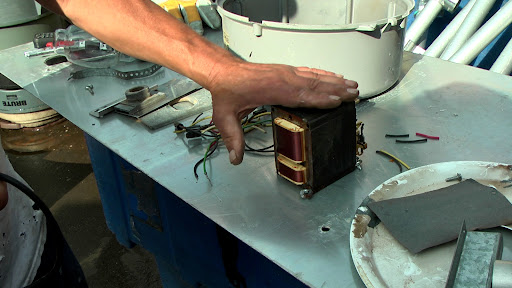Ballast recycling is revolutionizing the way we handle hazardous waste. This innovative approach not only benefits the environment but also offers significant advantages for businesses and communities. With the growing awareness of environmental sustainability, understanding the intricacies and importance of ballast recycling has become crucial for environmentalists, construction companies, and waste management providers alike.
Introduction to Ballast Recycling
Ballasts are integral components used in various industries, notably in lighting systems to regulate the current and voltage to lamps. They can be found in commercial buildings, street lighting, and even domestic settings. However, many fail to recognize the potential hazards associated with improper disposal of these components. The materials within ballasts, such as polychlorinated biphenyls (PCBs) and other heavy metals, can pose significant environmental threats if not properly managed.
Understanding ballast recycling begins with acknowledging its necessity. While these components effectively serve their purpose within electrical systems, their lifecycle does not end there. Ballast recycling provides a solution, turning what could be hazardous waste into an environmentally friendly resource. By breaking down and reprocessing these materials, we not only reduce environmental harm but also promote sustainable practices.
The Importance of Proper Disposal
Improper disposal of ballasts can lead to severe environmental impacts. When disposed of in landfills, the hazardous materials within can leach into the soil and groundwater, posing risks to ecosystems and human health. The regulatory landscape reflects the seriousness of this issue; stringent guidelines dictate the disposal and recycling of ballasts to mitigate these potential harms.
Regulatory requirements vary by region, but they generally emphasize the safe handling and processing of hazardous waste. Adhering to these regulations is not just a legal obligation but a moral one as well. Best practices in ballast disposal include using certified recycling facilities that follow strict environmental standards. By ensuring proper disposal, we protect our planet and demonstrate a commitment to responsible environmental stewardship.
Benefits of Ballast Recycling
The benefits of ballast recycling extend beyond environmental protection. By diverting hazardous waste from landfills, we significantly reduce the potential for soil and water contamination. This, in turn, contributes to healthier ecosystems and communities.
Economically, the recycling of ballasts presents opportunities for businesses to reduce costs associated with waste disposal. Additionally, recycling initiatives often create new jobs within the green economy, supporting economic growth while promoting sustainable practices. For communities, the environmental and economic benefits are clear, making ballast recycling a win-win scenario.
How Ballast Recycling Works
The process of recycling ballasts involves several crucial steps to ensure safety and efficiency. Initially, the collected ballasts are sorted and dismantled to separate hazardous materials from components that can be safely recycled. Specialized technologies and methods, such as thermal and chemical treatments, are employed to neutralize toxins and extract reusable materials like copper and aluminum.
Safety is paramount throughout the recycling process. Facilities are equipped with advanced technology to manage the hazards associated with handling toxic substances. The end goal is to repurpose as much of the material as possible, minimizing waste and maximizing resource recovery.
The Role of Key Stakeholders
Key stakeholders play a pivotal role in the success of ballast recycling initiatives. Environmentalists advocate for stricter regulations and increased awareness about the importance of hazardous waste management. Their insights and activism drive policy changes and societal shifts towards more sustainable practices.
Construction companies, as major users of ballasts, have the responsibility to adopt recycling practices as part of their operational protocols. Successful case studies, such as those from progressive firms, showcase how integrating recycling into their waste management strategies has led to reduced environmental footprints and cost savings.
Waste management providers are at the forefront of implementing effective recycling programs. Their expertise and infrastructure are critical for facilitating the collection, sorting, and processing of ballasts. By collaborating with other stakeholders, they can enhance the efficiency and reach of recycling efforts.
Challenges and Future Trends
Despite the clear benefits, ballast recycling faces several challenges. Obstacles such as limited public awareness, inconsistent regulatory frameworks, and the technical complexities involved in safely handling hazardous materials pose significant barriers. Overcoming these challenges requires concerted efforts from all involved parties, from policymakers to industry leaders.
Looking ahead, the future of ballast recycling is promising. Innovations in recycling technology and increased global emphasis on sustainability are driving positive change. Emerging trends such as circular economy models and advanced materials recovery techniques are set to redefine the landscape of hazardous waste management.
Encouraging Responsible Practices
Adopting responsible disposal practices is crucial for individuals and organizations alike. By participating in recycling programs and staying informed about the latest developments in waste management, we can collectively make a positive impact. Additionally, resources such as government guidelines and industry publications offer valuable information for those looking to deepen their understanding of ballast recycling.
In conclusion, ballast recycling is more than just a method of waste disposal; it’s a vital component of sustainable environmental management. Its importance to environmentalists, construction companies, and waste management providers cannot be overstated. By recognizing the significance of this process and taking actionable steps, we can contribute to a healthier planet and a more sustainable future.






